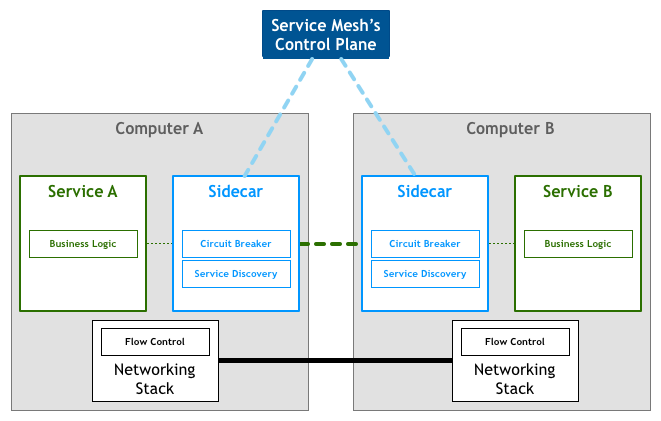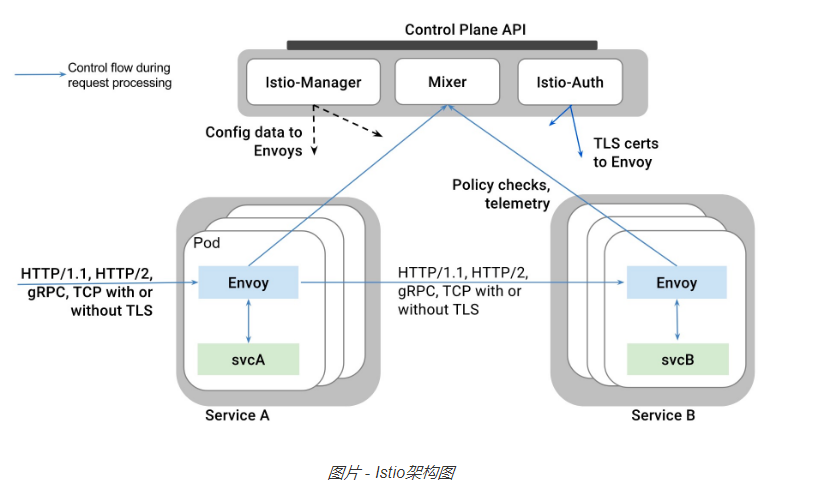Istio微服务架构初试
感谢
http://blog.csdn.net/qq_34463875/article/details/77866072
看了一些文档,有些半懂不懂,所以还是需要helloworld一下。因为istio需要kubernetes 1.7的环境,所以又把环境重新安装了一边,详情看随笔。
文章比较少,我也遇到不少问题,基本还是出于对一些东西的理解不够深刻,踩坑下来也算是学习啦。
重要事情先说一次
1.Kube-apiserver需要打开ServiceAccount配置
2.Kube-apiserver需要配置ServiceAccount
3.集群需要配置DNS
架构
理解微服务架构,就不得不提目前很火热的一个概念,服务网络。
Service Mesh是专用的基础设施层。
轻量级高性能网络代理。
提供安全的、快速的、可靠地服务间通讯。
与实际应用部署一起,但对应用透明。
应用作为服务的发起方,只需要用最简单的方式将请求发送给本地的服务网格代理,然后网格代理会进行后续的操作,如服务发现,负载均衡,最后将请求转发给目标服务。
先看一张Service Mesh的架构图

Istio 首先是一个服务网络,但是Istio又不仅仅是服务网格: 在 Linkerd, Envoy 这样的典型服务网格之上,Istio提供了一个完整的解决方案,为整个服务网格提供行为洞察和操作控制,以满足微服务应用程序的多样化需求。
Istio在服务网络中统一提供了许多关键功能(以下内容来自官方文档):
流量管理:控制服务之间的流量和API调用的流向,使得调用更可靠,并使网络在恶劣情况下更加健壮。
可观察性:了解服务之间的依赖关系,以及它们之间流量的本质和流向,从而提供快速识别问题的能力。
策略执行:将组织策略应用于服务之间的互动,确保访问策略得以执行,资源在消费者之间良好分配。策略的更改是通过配置网格而不是修改应用程序代码。
服务身份和安全:为网格中的服务提供可验证身份,并提供保护服务流量的能力,使其可以在不同可信度的网络上流转。
除此之外,Istio针对可扩展性进行了设计,以满足不同的部署需要:
平台支持:Istio旨在在各种环境中运行,包括跨云, 预置,Kubernetes,Mesos等。最初专注于Kubernetes,但很快将支持其他环境。
集成和定制:策略执行组件可以扩展和定制,以便与现有的ACL,日志,监控,配额,审核等解决方案集成。
这些功能极大的减少了应用程序代码,底层平台和策略之间的耦合,使微服务更容易实现。
istio架构图

Istio的关键功能包括:
- HTTP/1.1,HTTP/2,gRPC和TCP流量的自动区域感知负载平衡和故障切换。
- 通过丰富的路由规则,容错和故障注入,对流行为的细粒度控制。
- 支持访问控制,速率限制和配额的可插拔策略层和配置API。
- 集群内所有流量的自动量度,日志和跟踪,包括集群入口和出口。
- 安全的服务到服务身份验证,在集群中的服务之间具有强大的身份标识。
安装
下载地址 https://github.com/istio/istio/releases
我下载的是0.1.6版本。 https://github.com/istio/istio/releases/download/0.1.6/istio-0.1.6-linux.tar.gz
解压,然后下载镜像,涉及镜像包括
- istio/mixer:0.1.6
- pilot:0.1.6
- proxy_debug:0.1.6
- istio-ca:0.1.6

[root@node1 ~]# docker images
REPOSITORY TAG IMAGE ID CREATED SIZE
docker.io/tomcat 9.0-jre8 e882239f2a28 2 weeks ago 557.3 MB
docker.io/alpine latest 053cde6e8953 3 weeks ago 3.962 MB
registry.cn-hangzhou.aliyuncs.com/szss_k8s/k8s-dns-sidecar-amd64 1.14.5 fed89e8b4248 8 weeks ago 41.81 MB
registry.cn-hangzhou.aliyuncs.com/szss_k8s/k8s-dns-kube-dns-amd64 1.14.5 512cd7425a73 8 weeks ago 49.38 MB
registry.cn-hangzhou.aliyuncs.com/szss_k8s/k8s-dns-dnsmasq-nanny-amd64 1.14.5 459944ce8cc4 8 weeks ago 41.42 MB
gcr.io/google_containers/exechealthz 1.0 82a141f5d06d 20 months ago 7.116 MB
gcr.io/google_containers/kube2sky 1.14 a4892326f8cf 21 months ago 27.8 MB
gcr.io/google_containers/etcd-amd64 2.2.1 3ae398308ded 22 months ago 28.19 MB
gcr.io/google_containers/skydns 2015-10-13-8c72f8c 718809956625 2 years ago 40.55 MB
docker.io/kubernetes/pause latest f9d5de079539 3 years ago 239.8 kB
docker.io/istio/istio-ca 0.1.6 c25b02aba82d 292 years ago 153.6 MB
docker.io/istio/mixer 0.1.6 1f4a2ce90af6 292 years ago 158.9 MB
docker.io/istio/proxy_debug 0.1 5623de9317ff 292 years ago 825 MB
docker.io/istio/proxy_debug 0.1.6 5623de9317ff 292 years ago 825 MB
docker.io/istio/pilot 0.1.6 e0c24bd68c04 292 years ago 144.4 MB
docker.io/istio/init 0.1 0cbd83e9df59 292 years ago 119.3 MB

进入istio.yaml后先把pullPolicy给修改了
imagePullPolicy: IfNotPresent
然后运行
kubectl create -f istio-rbac-beta.yaml kubectl create -f istio.yaml
此处遇到无数问题,都和环境不ready相关
1.Kube-apiserver需要打开ServiceAccount配置
2.Kube-apiserver需要配置ServiceAccount
3.集群需要配置DNS
运行起来后一看service

[root@k8s-master kubernetes]# kubectl get services
NAME CLUSTER-IP EXTERNAL-IP PORT(S) AGE
helloworldsvc 10.254.145.112 <none> 8080/TCP 47m
istio-egress 10.254.164.118 <none> 80/TCP 14h
istio-ingress 10.254.234.8 <pending> 80:32031/TCP,443:32559/TCP 14h
istio-mixer 10.254.227.198 <none> 9091/TCP,9094/TCP,42422/TCP 14h
istio-pilot 10.254.15.121 <none> 8080/TCP,8081/TCP 14h
kubernetes 10.254.0.1 <none> 443/TCP 1d
tool 10.254.87.52 <none> 8080/TCP 44m

这个ingress服务一直处于pending状态,后来查了半天说和是否支持外部负载均衡有关,暂时不理。
准备测试应用
建立PV和PVC,初步设想是准备一个tomcat镜像,然后放上HelloWorld应用

[root@k8s-master ~]# cat pv.yaml
apiVersion: v1
kind: PersistentVolume
metadata:
name: pv0003
spec:
capacity:
storage: 1Gi
accessModes:
- ReadWriteOnce
persistentVolumeReclaimPolicy: Recycle
hostPath:
path: /webapps


[root@k8s-master ~]# cat pvc.yaml
kind: PersistentVolumeClaim
apiVersion: v1
metadata:
name: tomcatwebapp
spec:
accessModes:
- ReadWriteOnce
resources:
requests:
storage: 1Gi

关于HelloWorld应用
index.jsp

<%@ page language="java" contentType="text/html; charset=utf-8" import="java.net.InetAddress" pageEncoding="utf-8"%>
<html>
<body> This is a Helloworld test</body>
<%
System.out.println("this is a session test!"); InetAddress addr = InetAddress.getLocalHost();
out.println("HostAddress="+addr.getHostAddress());
out.println("HostName="+addr.getHostName()); String version = System.getenv("SERVICE_VERSION");
out.println("SERVICE_VERSION="+version); %>
</html>

建立第一个版本的rc-v1.yaml文件

[root@k8s-master ~]# cat rc-v1.yaml
apiVersion: extensions/v1beta1
kind: Deployment
metadata:
name: helloworld-service
spec:
replicas: 1
template:
metadata:
labels:
tomcat-app: "helloworld"
version: "1"
spec:
containers:
- name: tomcathelloworld
image: docker.io/tomcat:9.0-jre8
volumeMounts:
- mountPath: "/usr/local/tomcat/webapps"
name: mypd
ports:
- containerPort: 8080
env:
- name: "SERVICE_VERSION"
value: "1"
volumes:
- name: mypd
persistentVolumeClaim:
claimName: tomcatwebapp

rc-service文件

[root@k8s-master ~]# cat rc-service.yaml
apiVersion: v1
kind: Service
metadata:
name: helloworldsvc
labels:
tomcat-app: helloworld
spec:
ports:
- port: 8080
protocol: TCP
targetPort: 8080
name: http
selector:
tomcat-app: helloworld

然后通过istioctl kube-inject注入
istioctl kube-inject -f rc-v1.yaml > rc-v1-istio.yaml
注入后发现,多了一个Sidecar Container

[root@k8s-master ~]# cat rc-v1-istio.yaml
apiVersion: extensions/v1beta1
kind: Deployment
metadata:
creationTimestamp: null
name: helloworld-service
spec:
replicas: 1
strategy: {}
template:
metadata:
annotations:
alpha.istio.io/sidecar: injected
alpha.istio.io/version: jenkins@ubuntu-16-04-build-12ac793f80be71-0.1.6-dab2033
pod.beta.kubernetes.io/init-containers: '[{"args":["-p","15001","-u","1337"],"image":"docker.io/istio/init:0.1","imagePullPolicy":"IfNotPresent","name":"init","securityContext":{"capabilities":{"add":["NET_ADMIN"]}}},{"args":["-c","sysctl
-w kernel.core_pattern=/tmp/core.%e.%p.%t \u0026\u0026 ulimit -c unlimited"],"command":["/bin/sh"],"image":"alpine","imagePullPolicy":"IfNotPresent","name":"enable-core-dump","securityContext":{"privileged":true}}]'
creationTimestamp: null
labels:
tomcat-app: helloworld
version: "1"
spec:
containers:
- env:
- name: SERVICE_VERSION
value: "1"
image: docker.io/tomcat:9.0-jre8
name: tomcathelloworld
ports:
- containerPort: 8080
resources: {}
volumeMounts:
- mountPath: /usr/local/tomcat/webapps
name: mypd
- args:
- proxy
- sidecar
- -v
- "2"
env:
- name: POD_NAME
valueFrom:
fieldRef:
fieldPath: metadata.name
- name: POD_NAMESPACE
valueFrom:
fieldRef:
fieldPath: metadata.namespace
- name: POD_IP
valueFrom:
fieldRef:
fieldPath: status.podIP
image: docker.io/istio/proxy_debug:0.1
imagePullPolicy: IfNotPresent
name: proxy
resources: {}
securityContext:
runAsUser: 1337
volumes:
- name: mypd
persistentVolumeClaim:
claimName: tomcatwebapp
status: {}
---

inject之后又要下载几个镜像 :(
- docker.io/istio/proxy_debug:0.1
- docker.io/istio/init:0.1
- alpine
同时注意把imagePullPolicy改掉。。。。
再运行
kubectl create -f rc-v1-istio.yaml
此处又遇到无数坑
1.权限问题,需要在/etc/kubernetes/config下打开--allow-privileged,master和节点都需要打开

[root@k8s-master ~]# cat /etc/kubernetes/config
###
# kubernetes system config
#
# The following values are used to configure various aspects of all
# kubernetes services, including
#
# kube-apiserver.service
# kube-controller-manager.service
# kube-scheduler.service
# kubelet.service
# kube-proxy.service
# logging to stderr means we get it in the systemd journal
KUBE_LOGTOSTDERR="--logtostderr=true" # journal message level, 0 is debug
KUBE_LOG_LEVEL="--v=0" # Should this cluster be allowed to run privileged docker containers
KUBE_ALLOW_PRIV="--allow-privileged=true" # How the controller-manager, scheduler, and proxy find the apiserver
KUBE_MASTER="--master=http://192.168.44.108:8080"

2.发现只要一加上 securityContext: runAsUser: 1337 POD无论如何都不启动,去掉至少可以启动,一直在desired阶段,因为提示信息有限,比较烧脑,后发现需要修改APIServer中的配置,去掉--admission-control=NamespaceLifecycle,LimitRanger,SecurityContextDeny,ResourceQuota,ServiceAccount中的SecurityContextDeny
最后kube-apiserver配置为

[root@k8s-master ~]# cat /etc/kubernetes/apiserver
###
# kubernetes system config
#
# The following values are used to configure the kube-apiserver
# # The address on the local server to listen to.
KUBE_API_ADDRESS="--insecure-bind-address=192.168.44.108" # The port on the local server to listen on.
# KUBE_API_PORT="--port=8080" # Port minions listen on
# KUBELET_PORT="--kubelet-port=10250" # Comma separated list of nodes in the etcd cluster
KUBE_ETCD_SERVERS="--etcd-servers=http://192.168.44.108:2379" # Address range to use for services
KUBE_SERVICE_ADDRESSES="--service-cluster-ip-range=10.254.0.0/16" # default admission control policies
#KUBE_ADMISSION_CONTROL="--admission-control=NamespaceLifecycle,NamespaceExists,LimitRanger,ServiceAccount,SecurityContextDeny,ResourceQuota"
KUBE_ADMISSION_CONTROL="--admission-control=NamespaceLifecycle,NamespaceExists,LimitRanger,ServiceAccount,ResourceQuota" # Add your own!
KUBE_API_ARGS="--secure-port=443 --client-ca-file=/srv/kubernetes/ca.crt --tls-cert-file=/srv/kubernetes/server.cert --tls-private-key-file=/srv/kubernetes/server.key"

好了,搞完能顺利启动。
再建立一个rc-v2.yaml

[root@k8s-master ~]# cat rc-v2.yaml
apiVersion: extensions/v1beta1
kind: Deployment
metadata:
name: helloworld-service-v2
spec:
replicas: 1
template:
metadata:
labels:
tomcat-app: "helloworld"
version: "2"
spec:
containers:
- name: tomcathelloworld
image: docker.io/tomcat:9.0-jre8
volumeMounts:
- mountPath: "/usr/local/tomcat/webapps"
name: mypd
ports:
- containerPort: 8080
env:
- name: "SERVICE_VERSION"
value: "2"
volumes:
- name: mypd
persistentVolumeClaim:
claimName: tomcatwebapp

tool.yaml,用于在服务网络中进行测试用.其实就是一个shell

[root@k8s-master ~]# cat tool.yaml
apiVersion: extensions/v1beta1
kind: Deployment
metadata:
name: tool
spec:
replicas: 1
template:
metadata:
labels:
name: tool
version: "1"
spec:
containers:
- name: tool
image: docker.io/tomcat:9.0-jre8
volumeMounts:
- mountPath: "/usr/local/tomcat/webapps"
name: mypd
ports:
- containerPort: 8080
volumes:
- name: mypd
persistentVolumeClaim:
claimName: tomcatwebapp
---
apiVersion: v1
kind: Service
metadata:
name: tool
labels:
name: tool
spec:
ports:
- port: 8080
protocol: TCP
targetPort: 8080
name: http
selector:
name: tool

两个都需要kube-inject并且通过apply进行部署。
最后结果

[root@k8s-master ~]# kubectl get pods
NAME READY STATUS RESTARTS AGE
helloworld-service-2437162702-x8w05 2/2 Running 0 1h
helloworld-service-v2-2637126738-s7l4s 2/2 Running 0 1h
istio-egress-2869428605-2ftgl 1/1 Running 2 14h
istio-ingress-1286550044-6g3vj 1/1 Running 2 14h
istio-mixer-765485573-23wc6 1/1 Running 2 14h
istio-pilot-1495912787-g5r9s 2/2 Running 4 14h
tool-185907110-fsr04 2/2 Running 0 1h

流量分配
建立一个路由规则
istioctl create -f default.yaml

[root@k8s-master ~]# cat default.yaml
type: route-rule
name: helloworld-default
spec:
destination: helloworldsvc.default.svc.cluster.local
precedence: 1
route:
- tags:
version: "2"
weight: 10
- tags:
version: "1"
weight: 90

也就是访问helloworldsvc,有90%的流量会访问到version 1的pod,而10%的流量会访问到version 2的节点
如何判断这个helloworldsvc确实是指到后端两个pod呢,可以通过下面命令确认

[root@k8s-master ~]# kubectl describe service helloworldsvc
Name: helloworldsvc
Namespace: default
Labels: tomcat-app=helloworld
Annotations: <none>
Selector: tomcat-app=helloworld
Type: ClusterIP
IP: 10.254.145.112
Port: http 8080/TCP
Endpoints: 10.1.40.3:8080,10.1.40.7:8080
Session Affinity: None
Events: <none>

说明service和deployment的配置没有问题
进入到tools
[root@k8s-master ~]# kubectl exec -it tool-185907110-fsr04 bash
Defaulting container name to tool.
Use 'kubectl describe pod/tool-185907110-fsr04' to see all of the containers in this pod.
root@tool-185907110-fsr04:/usr/local/tomcat#
运行

<usr/local/tomcat# curl helloworldsvc:8080/HelloWorld/index.jsp <html>
<body> This is a Helloworld test</body>
HostAddress=10.1.40.3
HostName=helloworld-service-v2-2637126738-s7l4s
SERVICE_VERSION=2

这里又折腾很久,开始怎么都返回connection refuse,在pod中访问localhost通但curl ip不通,后来尝试采用不注入的tool发现没有问题,但并不进行流量控制,最后又切换会inject后的pod后居然发现能够联通了,解决方法是: 把inject的重新create一遍,同时把service又create一遍。
写个shell脚本
echo "for i in {1..100}
do
curl -s helloworldsvc:8080/HelloWorld/index.jsp | grep SERVICE_VERSION
done" > batch.sh
然后运行

然后通过grep统计验证流量分布
root@tool-185907110-fsr04:/usr/local/tomcat# ./batch.sh | grep 2 | wc -l
10
root@tool-185907110-fsr04:/usr/local/tomcat# ./batch.sh | grep 1 | wc -l
90
超时策略

[root@k8s-master ~]# cat delay.yaml
type: route-rule
name: helloworld-timeout
spec:
destination: helloworldsvc.default.svc.cluster.local
precedence: 9
route:
- tags:
version: "1"
httpReqTimeout:
simpleTimeout:
timeout: 2s

设置2秒超时,然后继续Curl
root@tool-185907110-nrn9l:/usr/local/tomcat# curl -s helloworldsvc:8080/HelloWorld/delay.jsp
upstream request timeout
需要注意的是开始怎么也不生效,后来把tool工具的pod删除再重新建立就可以了
重试策略
需要先把之前的timeout去掉

[root@k8s-master ~]# cat retry.yaml
type: route-rule
name: helloworld-timeout
spec:
destination: helloworldsvc.default.svc.cluster.local
precedence: 9
route:
- tags:
version: "1"
httpReqRetries:
simpleRetry:
attempts: 2
perTryTimeout: 2s

访问结果

root@tool-185907110-ms991:/usr/local/tomcat# curl -s helloworldsvc:8080/HelloWorld/delay.jsp
upstream request timeout root@tool-185907110-ms991:/usr/local/tomcat# curl -s helloworldsvc:8080/HelloWorld<transfer}:%{time_total}\n' 'helloworldsvc:8080/HelloWorld/delay.jsp ' 0.004545:6.087113:6.087190

超时后每次两秒都没出来,重试了2次
未完待续。。。
Istio微服务架构初试的更多相关文章
- 微服务架构基础之Service Mesh
ServiceMesh(服务网格) 概念在社区里头非常火,有人提出 2018 年是 ServiceMesh 年,还有人提出 ServiceMesh 是下一代的微服务架构基础. 那么到底什么是 Serv ...
- 微服务架构之「 下一代微服务 Service Mesh 」
Service Mesh 被大家称为下一代的微服务,是微服务领域的一颗新星,被大家讨论的非常多. 我在大家的讨论中,还看到有人说 “目前的微服务架构我都没学会呢,现在又来一个下一代微服务,真学不动了” ...
- 微服务, 架构, 服务治理, 链路跟踪, 服务发现, 流量控制, Service Mesh
微服务, 架构, 服务治理, 链路跟踪, 服务发现, 流量控制, Service Mesh 微服务架构 本文将介绍微服务架构和相关的组件,介绍他们是什么以及为什么要使用微服务架构和这些组件.本文侧 ...
- 在微服务架构中service mesh是什么?
在微服务架构中service mesh是什么 什么是 service mesh ? 微服务架构将软件功能隔离为多个独立的服务,这些服务可独立部署,高度可维护和可测试,并围绕特定业务功能进行组织. 这些 ...
- 基于 Apache APISIX 的下一代微服务架构
2019 年 12 月 14 日,又拍云联合 Apache APISIX 社区举办 API 网关与高性能服务最佳实践丨Open Talk 广州站活动,Apache APISIX PPMC 温铭做了题为 ...
- Dapr Actor 的微服务架构
Dapr中的Actor模型,和Orleans的Virtual Actor一脉相传, 圣杰写过一篇文章Orleans 知多少 | .NET Core 分布式框架介绍过.简单来讲:Actor模型 = 状态 ...
- CI Weekly #5 | 微服务架构下的持续部署与交付
CI Weekly 围绕『 软件工程效率提升』 进行一系列技术内容分享,包括国内外持续集成.持续交付,持续部署.自动化测试. DevOps 等实践教程.工具与资源,以及一些工程师文化相关的程序员 Ti ...
- 【DDD/CQRS/微服务架构案例】在Ubuntu 14.04.4 LTS中运行WeText项目的服务端
在<WeText项目:一个基于.NET实现的DDD.CQRS与微服务架构的演示案例>文章中,我介绍了自己用Visual Studio 2015(C# 6.0 with .NET Frame ...
- WeText项目:一个基于.NET实现的DDD、CQRS与微服务架构的演示案例
最近出于工作需要,了解了一下微服务架构(Microservice Architecture,MSA).我经过两周业余时间的努力,凭着自己对微服务架构的理解,从无到有,基于.NET打造了一个演示微服务架 ...
随机推荐
- C#应用视频教程2.4 OPENGL虚拟仿真介绍
这一部分我们首先实现视图控制(包括了平移/旋转/缩放),前面我们已经讲过,通过lookat一个函数,或者通过translate+rotate两个函数,都能实现视图的控制(两个函数的方式比较简单,但是通 ...
- C#基础视频教程4.2 如何编写简单的计算器
用过VB6或者早期代码的人都应该能感觉到,C#目前也没看出来有什么特别之处,所谓的面向对象也没有什么体现.所以我们需要在原有基础上重写一份代码,然后比较两种做法的优缺点.我们在项目上右击添加一个Fun ...
- Oracle 之 常用函数
SQL语句根据参数的不同,分为单行函数 和 多行函数. [1] 单行函数:输入是一行,输出也是一行: [2] 多行函数:输入多行数据,输出一个结果. 在执行时,单行函数是检索一行处理一次,而多行函数是 ...
- selenium 问题:OSError: [WinError 6] 句柄无效
问题: 执行多个用例的时候,会抛出异常: File "xxxxxx.py", line 16, in get_driver driver = webdriver.Chrome(ex ...
- Jquery重新学习之九[Ajax运用总结C]
前两篇文章主要介绍Jquery如何利用Ajax进行操作数据,主要介绍调用的方法:其中Jquery.ajax()是Jquery中最底层的方法:Jquery还定义的一个方法跟几个事件为Jquery.aja ...
- ant design 中的 Select 组件常规写法
1.代码 import { Select, Spin } from 'antd'; const Option = Select.Option; <Select allowClear showSe ...
- OPENERP 构建动态视图
来自:http://shine-it.net/index.php/topic,16142.0.html 在openerp展示界面通常是通过定义class的view(xml文件)来实现的. 有时这种方法 ...
- Linux-软件包管理-rpm命令管理-校验、文件提取
rpm -V httpd 查看已安装的apache包中文件信息是否已经被人修改 rpm -ql httpd 查看已安装的apache包中文件的位置 vim /etc/httpd/conf/httpd. ...
- hibernate中一对一映射
一.hibernate中一对一映射有两种 1 主键方式,一张表的主键是通过另一张表的主键生成的 2 外键方式,一张表添加外键引用另一张表的主键,并添加唯一unique约束 二.下面进行简单例子,用户和 ...
- Mysql User表权限字段说明全介绍
一:mysql权限表user字段详解: Select_priv.确定用户是否可以通过SELECT命令选择数据. Insert_priv.确定用户是否可以通过INSERT命令插入数据. Update_p ...
